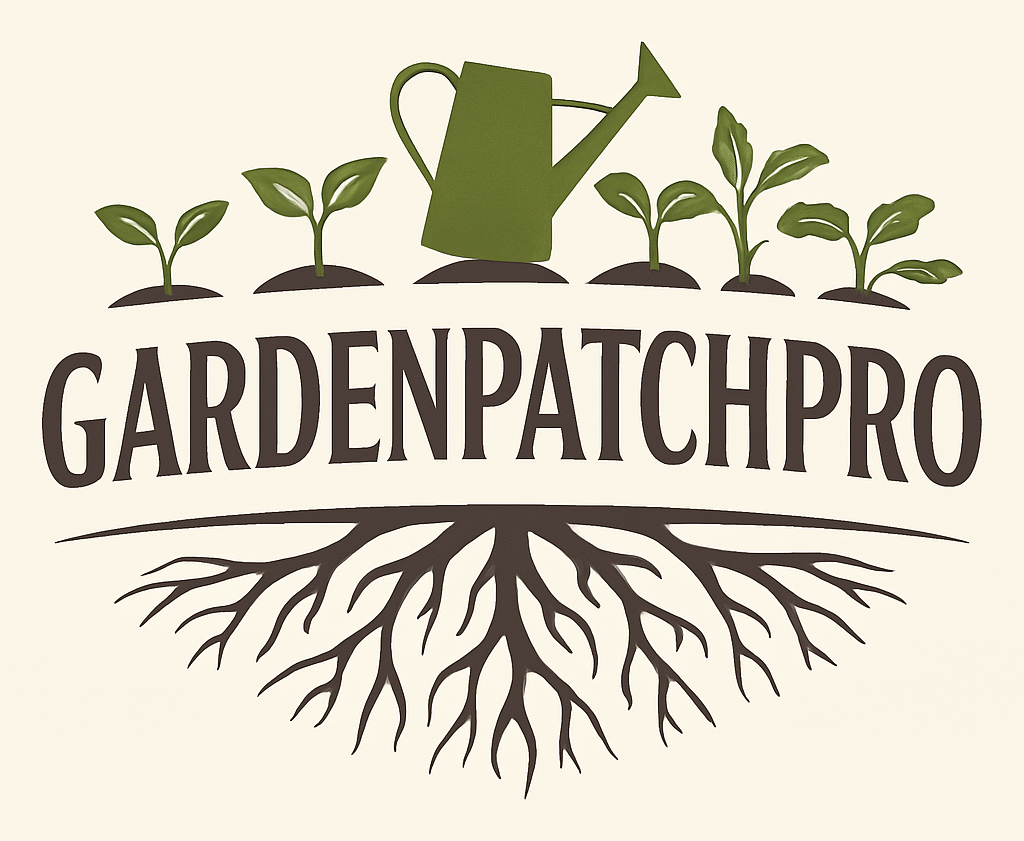Grow Vegetables Indoors: Essential Guide to Year-Round Harvests
Growing vegetables indoors is a practical way to enjoy fresh produce all year long, no matter the season or space constraints. Indoor gardening makes it possible to cultivate a variety of vegetables by controlling light, temperature, and soil conditions, ensuring consistent growth and harvest. This approach works well for people who live in apartments, have limited outdoor space, or want to extend their growing season beyond the warmer months.
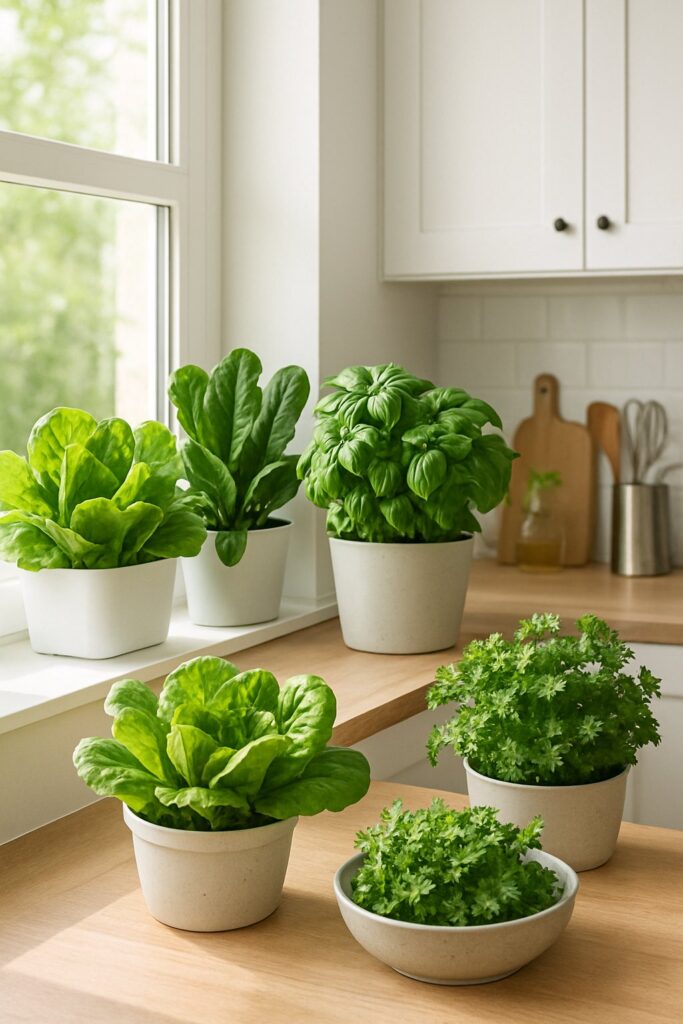
Many vegetables thrive in containers inside the home, such as lettuce, tomatoes, carrots, and herbs. Proper lighting and regular care are essential to help plants grow strong and healthy indoors. With the right setup, even beginners can successfully grow vegetables in small spaces like windowsills or shelves, making indoor gardening both accessible and rewarding.
Key Takeways
- Growing vegetables indoors allows for fresh produce year-round regardless of outdoor conditions.
- Selecting the right space and providing proper light are key to indoor vegetable success.
- Many common vegetables can be grown easily with minimal space and care indoors.
Benefits of Growing Vegetables Indoors
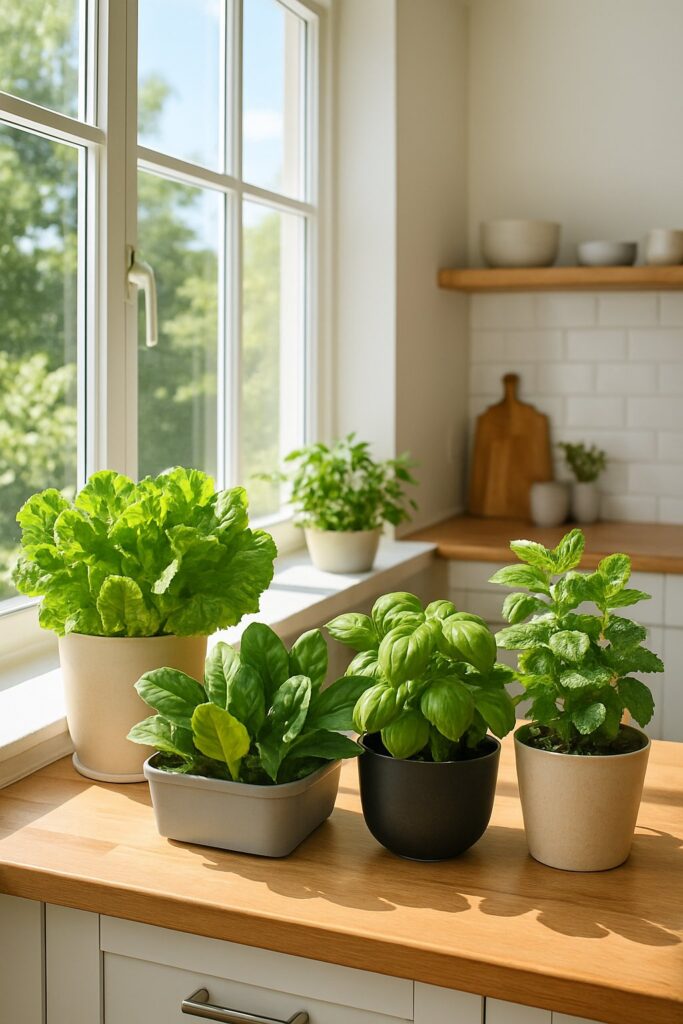
Growing vegetables indoors offers practical advantages like fresh produce any time of the year, smart use of limited space, and several health and environmental benefits. It lets people take control of their food and living environment in meaningful ways.
Enjoying Homegrown Produce Year-Round
Indoor vegetable gardening allows for a continuous supply of fresh vegetables regardless of the season. People can pick ripe tomatoes, herbs, or leafy greens whenever they want, which often leads to better flavor and nutrition compared to store-bought options.
Since growing conditions like light, temperature, and moisture are controlled indoors, there is no need to wait for outdoor growing seasons. This also means fewer worries about bad weather ruining crops. Plants such as cherry tomatoes, spinach, and peppers thrive indoors, making it easier to maintain a steady harvest all year round.
Space Efficiency and Indoor Gardening for Small Homes
Indoor gardening fits well with small homes or apartments because it doesn’t require a large outdoor plot. Using vertical gardening, pots, and shelves, one can grow many vegetables in tight spaces. This approach maximizes use of every available inch.
Small-scale systems can include simple containers or advanced setups with automated lighting and watering. This flexibility means beginners and experienced gardeners alike can grow a variety of vegetables effectively indoors, even in compact city apartments. It is a great choice for those with limited outdoor space but who want the benefits of homegrown produce.
Health and Sustainability Advantages
Growing vegetables indoors helps people eat healthier by providing easy access to fresh and pesticide-free food. Since they control everything from seeds to watering, indoor gardeners avoid chemicals commonly found in store produce.
Indoor gardening also lowers reliance on imported food, reducing transportation emissions and plastic waste from packaging. Hydroponic or aquaponic systems inside the home use less water than traditional farming. Additionally, caring for plants offers mental health benefits by reducing stress and encouraging a calming routine. These factors combine to promote both personal and environmental wellness.
More details about these benefits can be found at 9 Benefits of Growing Vegetables Indoors – IronCabin.
Best Vegetables to Grow Indoors
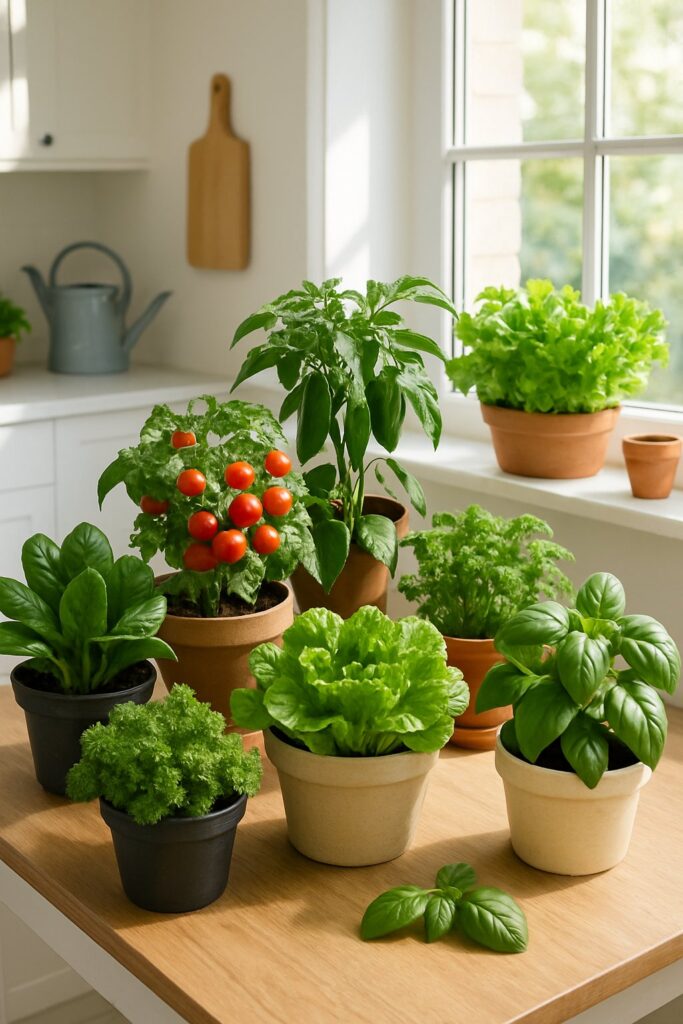
Growing vegetables indoors requires careful choice of varieties that thrive in containers with limited space and light. Some plants need shallow soil, while others require deeper containers. Light needs vary, so supplemental lighting might be necessary for some vegetables to grow well year-round.
Top Leafy Greens: Spinach, Kale, and Arugula
Leafy greens like spinach, kale, and arugula are excellent for indoor gardens due to their fast growth and low space requirements. Spinach prefers cooler temperatures and partial shade, making it ideal for indoor spots without full sun. It grows best in about 4 to 6 inches of soil and needs regular watering.
Kale is slightly tougher and more cold-tolerant than spinach. It requires at least 6 hours of light daily and a container with rich, well-drained soil. Regular harvesting of outer leaves encourages the plant to keep producing.
Arugula grows quickly and thrives in shallow containers with moist, fertile soil. It needs bright, indirect light and matures in as little as 30 days. These leafy greens provide fresh, nutritious leaves that can be harvested multiple times indoors.
Root Vegetables: Carrots and Radishes
Carrots and radishes adapt well to indoor growing if given the right container depth and soil conditions. Smaller carrot varieties are best, needing about 12 inches of loose, well-draining soil to develop straight roots. Containers like window boxes work well, and consistent moisture is important to avoid dry seeds or cracked roots.
Radishes grow faster than carrots, usually maturing in 30 to 60 days. They require a container roughly 6 inches deep and prefer full sun or strong artificial light. Radishes should be spaced at least three inches apart to allow room for bulbs to form. Staggered planting ensures a continuous supply through the season.
Both vegetables benefit from light soil and steady watering to avoid common indoor growing problems like mold or weak roots.
Fruit-Bearing Options: Tomatoes and Microgreens
Tomatoes and microgreens offer different but rewarding indoor growing experiences. Tomatoes need a deep container, about 12 inches or more, with rich, well-drained soil. They require at least 10 hours of light daily to fruit properly. Regular pollination by gently shaking flowers or using a small brush is necessary indoors since wind and insects are absent.
Microgreens are fast-growing, harvested quickly after sprouting, and need very shallow trays filled with a peat-based mix. They thrive under 18 hours of artificial light and can be grown from a variety of seeds like basil, radish, or kale. Microgreens need frequent misting to keep soil moist but not soaked. They are ready to harvest in 14 to 21 days, providing a nutrient-rich crop in minimal space.
Both options allow indoor gardeners to enjoy fresh, homegrown vegetables even without outdoor garden access.
For detailed advice on growing these vegetables indoors, refer to the guide on the best vegetables to grow indoors.
Setting Up Your Indoor Vegetable Garden
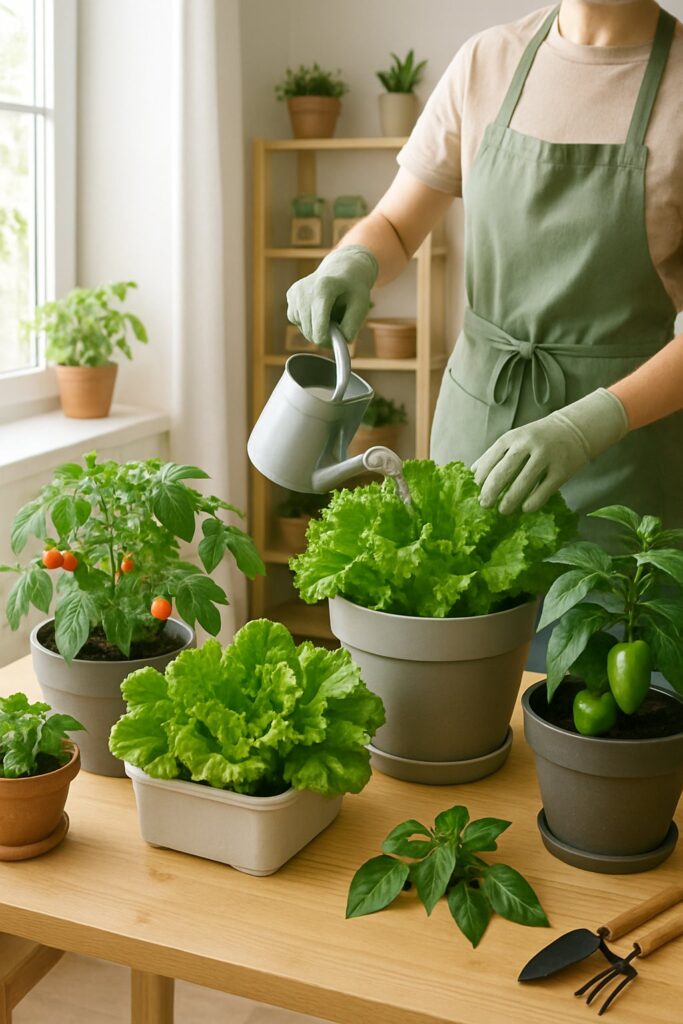
Successful indoor vegetable gardening starts with the right equipment and space arrangement. Containers must support healthy root growth and drainage. Light access and air circulation must be carefully planned to maximize plant health and crop yield.
Choosing Containers and Growing Medium
Containers with drainage holes are essential to prevent water buildup, which can cause root rot. Ideal containers include plastic pots, terracotta, or grow bags, chosen based on the plant type and available space. For instance, grow bags work well for root vegetables like carrots and potatoes.
The growing medium can be high-quality organic potting soil or a soil-less mix. Soil-less mixes are cleaner and lighter but need regular fertilizing, as they lack natural nutrients. Using fertilizers designed for vegetables supports steady growth. Compost blends or adding vermicompost can improve soil nutrients if soil is used.
Containers should be sized to fit the vegetable type, with larger pots for deep-rooted plants like tomatoes and smaller ones for herbs or salad greens.
Optimal Placement and Indoor Garden Layout
Placement should allow plants to get enough natural light near windows, ideally south-facing if possible, for 8-14 hours of light depending on the vegetable. When natural sunlight is limited, especially in winter, LED grow lights provide the full light spectrum plants need without excess heat.
Space plants to ensure good air circulation. Crowding can increase mold and fungal risks and weaken stems. Using shelves or plant stands can help maximize vertical space while keeping plants within reach of light.
Placement near a sunny window can also provide natural warmth. For plants requiring higher heat, additional heating or warm spots like a sunny counter may be necessary. Avoid locations with drafts or fluctuating temperatures.
Lighting Requirements for Indoor Vegetables
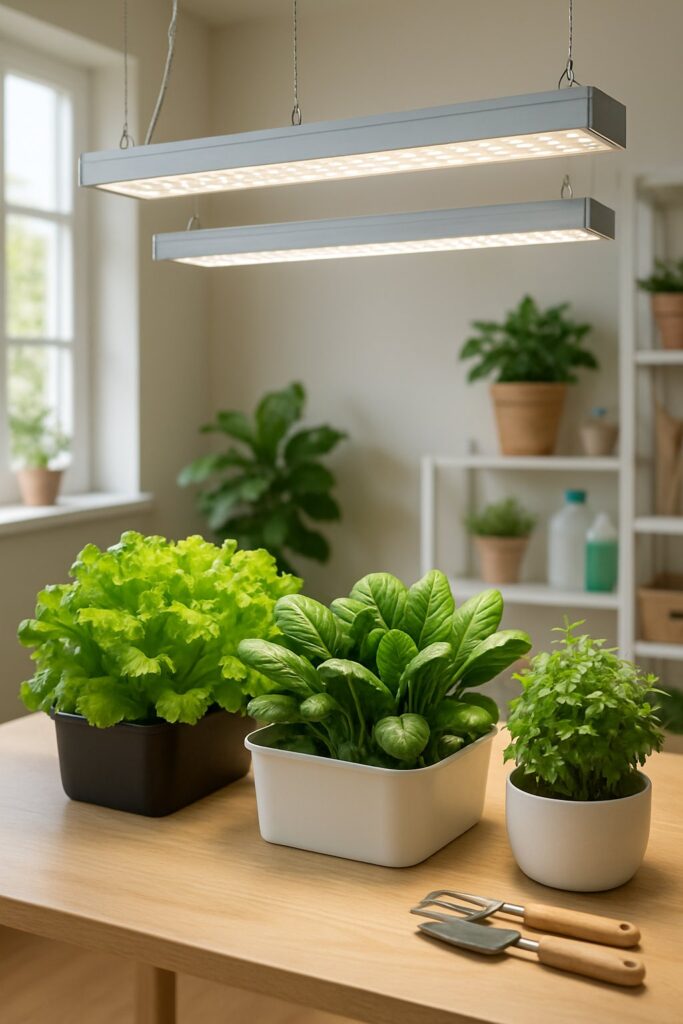
Lighting is critical for growing vegetables indoors. Plants need enough light to perform photosynthesis and develop properly. The right balance between light type, intensity, and duration helps vegetables thrive indoors, whether from natural or artificial sources.
Natural Light Versus Artificial Lighting
Natural light varies depending on the season, location, and room orientation. Most vegetables need 14 to 16 hours of light daily for optimal growth, which is hard to achieve naturally indoors during winter months.
Windows that face south typically provide the most natural light. However, even then, light intensity may be too low for fruiting vegetables like tomatoes or peppers. Leafy greens and herbs require less light and can handle lower intensities.
Artificial lighting supplements or replaces natural light to provide a consistent, measurable light source. It allows growing vegetables indoors year-round regardless of outdoor conditions. Timing is important—grow lights are usually set for 14-16 hours on and 6-10 hours off to mimic a natural day-night cycle.
LED Grow Lights and Full-Spectrum LED Lights
LED grow lights have grown popular for indoor vegetable gardening due to their energy efficiency and low heat output. They last longer and consume less electricity than fluorescent or HID lights.
Full-spectrum LED lights emit a broad range of light wavelengths, including both blue and red light. Blue light encourages leaf growth, while red light promotes flowering and fruiting. Using full-spectrum LEDs supports healthy development for leafy greens, herbs, and fruit vegetables.
For best results, LEDs should be placed 12 to 24 inches above plants. Adjusting the distance as plants grow ensures they get enough light without overheating. LEDs also allow precise control over light cycles, which helps in setting optimal lighting for different vegetable types.
Shop Lights for Small Scale Growing
Shop lights, usually equipped with fluorescent bulbs or LED tubes, offer an affordable and easy option for small indoor gardens. They often come in long strips that can cover multiple plants at once.
They are best suited for growing leafy greens, herbs, and seedlings that do not require intense light. Fluorescent shop lights produce minimal heat, making them safe for close placement—about 3 to 12 inches above plants.
While shop lights are less efficient and shorter-lived compared to full-spectrum LED grow lights, they remain a reliable choice for beginners or those growing a few plants indoors. Using shop lights along with reflective surfaces can increase light intensity and maximize plant growth. For more detailed advice on grow lights, see this guide on the best grow lights for growing vegetables indoors.
Hydroponics and Alternative Indoor Growing Methods
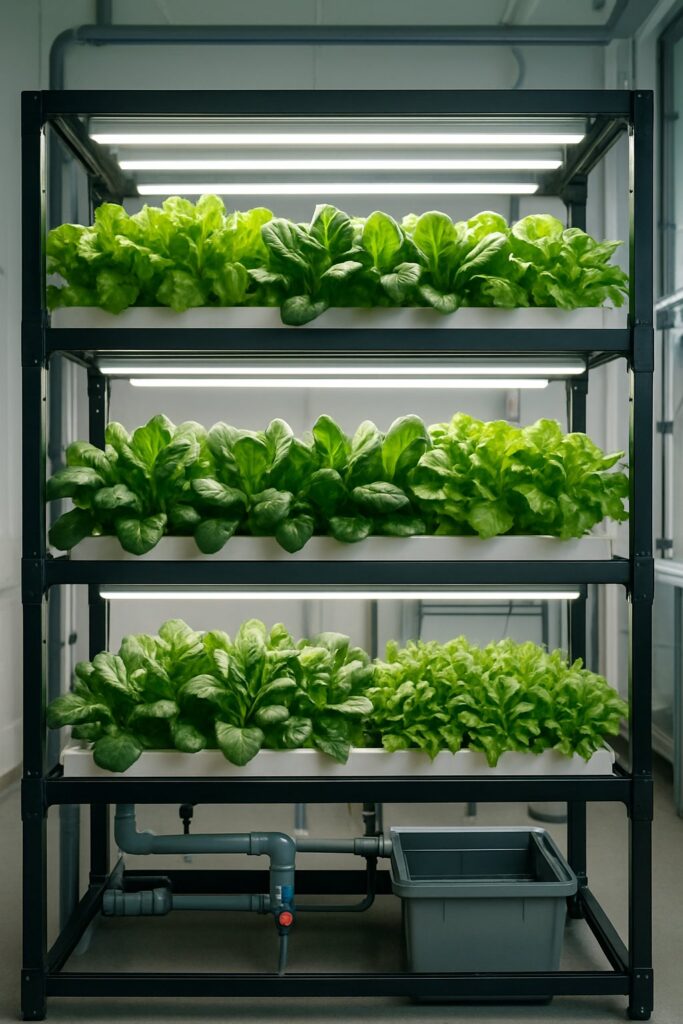
Growing vegetables indoors can be done in different ways, with systems that use soil or those that don’t. Hydroponics is a popular soil-free method that uses water and nutrients to grow plants efficiently. Understanding these options helps choose the best approach for the space and crops.
Basics of Hydroponic Vegetable Gardening
Hydroponics grows plants in nutrient-rich water instead of soil. This method lets plants absorb nutrients directly, often resulting in faster growth.
The common hydroponic systems include Deep Water Culture (DWC), nutrient film technique, and the Kratky method. The Kratky method is passive and simple, requiring no pumps or electricity, making it ideal for beginners.
Hydroponics indoor systems use grow lights because most vegetables need strong, consistent light indoors. LED grow lights are preferred for their efficiency and low heat output.
Leafy greens and herbs like lettuce, basil, and spinach are the easiest to start with because they have short growth cycles and low light needs. These systems save space and water, making indoor gardening more practical year-round.
Comparing Soil vs. Hydroponics for Different Crops
Soil gardening indoors uses pots with growing media like potting mix. It’s familiar but can require more space and water. Some crops do better here due to root support and natural soil bacteria.
Hydroponics suits plants that grow quickly or have shallow roots, such as lettuce, herbs, and microgreens. Fruiting vegetables like tomatoes and peppers grow well too but need more care in nutrient balance and support.
Root vegetables like carrots and potatoes often do better in soil because they need deep space that hydroponic systems might not provide easily.
Comparison Table:
| Factor | Soil Gardening | Hydroponics |
|---|---|---|
| Space Efficiency | Larger space needed | Saves space with vertical options |
| Water Usage | Higher | Uses 70-90% less water |
| Crop Suitability | Root crops and wide range | Leafy greens, herbs, fruiting plants |
| Setup Complexity | Simple to start | May require equipment and monitoring |
| Maintenance | Fertilizing, watering | pH and nutrient level monitoring |
Each method offers advantages depending on the plants grown and the grower’s goals in indoor gardening.
Starting Seeds Indoors and Maintenance Tips
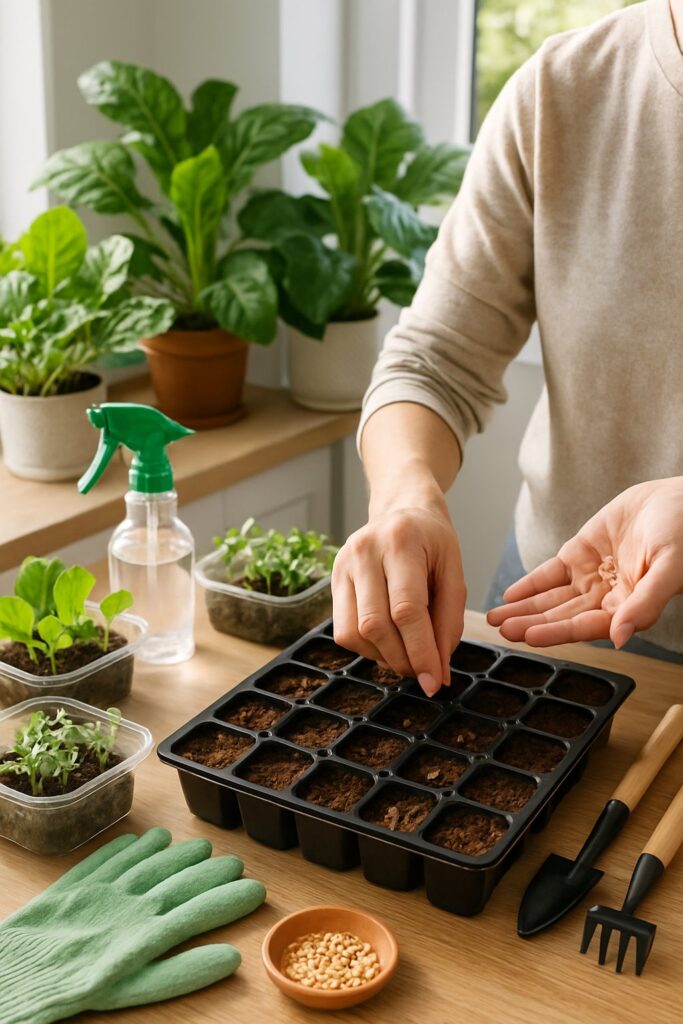
Starting seeds indoors allows gardeners to control temperature, light, and moisture for better germination and healthy seedlings. Proper care includes choosing the right containers, maintaining consistent moisture, and managing nutrition and pests. These details help indoor vegetable gardens thrive from the first sprout to transplant.
Seed Starting Techniques for Indoor Gardens
Seeds should be planted in small individual containers with drainage holes to prevent waterlogging and root damage. Using a sterile, soilless seed-starting mix made of peat and vermiculite provides a clean, lightweight environment ideal for germination.
Seeds must be planted at a depth about twice their size. Some seeds require light to germinate and should be lightly covered with fine vermiculite, while others need darkness and should be kept covered until sprouting. Labeling containers clearly prevents mix-ups.
Maintaining soil temperature near 65-75°F encourages faster germination. Bottom heat mats can help keep the soil warm, especially in cooler rooms. Avoid windowsills because fluctuating temperatures and uneven light can harm seedlings.
Artificial lights such as LED or fluorescent grow lights placed 2 to 4 inches above seedlings provide consistent light for 12 to 16 hours a day. This prevents seedlings from growing tall and weak. Raising the lights as plants grow ensures even coverage.
Watering, Fertilizing, and Pest Management
Keep the potting mix moist but not soggy to avoid damping off, a fungal disease that kills young seedlings. Water gently using a spray bottle or bottom watering to protect delicate roots and prevent soil displacement.
Seedlings usually don’t need fertilizer until their first true leaves develop. Then a quarter strength, water-soluble general-purpose fertilizer once a week supports healthy growth. Avoid over-fertilizing, which can harm young plants.
Regularly check for pests like aphids or fungus gnats, common in indoor gardens. Remove pests by hand or use natural controls like insecticidal soap. Good air circulation and clean containers reduce disease risk.
Removing any weak or crowded seedlings early helps remaining plants grow stronger by reducing competition for light and nutrients. Starting seeds with these care methods increases the chance of growing healthy vegetables indoors.
For detailed seed planting and care tips, see starting seeds indoors at UMN Extension.
Frequently Asked Questions
Growing vegetables indoors requires choosing the right plants, managing light and temperature, and using proper containers and soil. Successful indoor gardening also involves techniques to keep plants healthy throughout all seasons, even in limited spaces.
What are the best vegetables to start with for beginners growing indoors?
Beginners should start with small, easy-to-manage plants like leafy greens, green onions, and dwarf tomatoes. These plants require less space and have simpler care needs compared to sprawling or heavy-feeding vegetables.
How can you grow vegetables indoors if you don’t have access to natural sunlight?
Using grow lights that provide 16-18 hours of bright light daily is essential for fruiting plants like tomatoes and peppers. Leafy greens can manage with less light, but most indoor vegetables benefit from full-spectrum LED or fluorescent grow lights.
Which vegetables are suitable for indoor cultivation during the winter months?
Leafy greens such as lettuce, spinach, and kale do well in winter indoors. Herbs like basil and chives are also good choices. Compact fruiting plants like determinate tomatoes can survive indoors with enough light and warmth.
What are the essentials for setting up an indoor growing space using grow lights?
A grow space needs adequate room for pots with good drainage, quality potting mix, and temperature control between 65-75°F. Lights should be adjustable to keep them close to the plants without burning them. Fans for air circulation help prevent mold and pests.
Can you recommend a comprehensive indoor vegetable growing kit for home use?
Kits that include LED grow lights, containers, quality potting mix, and fertilizer make starting easier. Many kits also have timers and instructional guides tailored for beginners, providing all tools needed for basic indoor gardening.
What practices enable year-round vegetable cultivation in an apartment setting?
Regularly rotating pots to ensure even light exposure, hand-pollinating flowers of fruiting plants, and using organic fertilizers every 2-4 weeks support continued growth. Monitoring soil moisture to avoid overwatering and controlling temperature and humidity are also crucial for steady productivity.
For more detailed guidance on these topics, see tips for growing vegetables indoors successfully.
